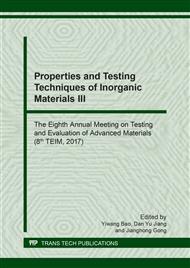[1]
J. Kesselmeier, M. Staudt, Biogenic Volatile Organic Compounds (VOC): an overview on emission, Physiology and Ecology, 33(1) (1999) 23-88.
Google Scholar
[2]
A.P. Jones, Indoor air quality and health, 33(28) (1999) 4535-4564.
Google Scholar
[3]
C. Lahousse, A. Bernier, P. Grange, et al., Evaluation of gamma-MnO2 as a VOC removal catalyst: comparison with a noble metal catalyst, J. Catal. 178(1) (1998) 214-225.
DOI: 10.1006/jcat.1998.2148
Google Scholar
[4]
G. Leson, A.M. Winer, Biofiltration-aninnovativeair-pollutioncontroltechnology for VOC emissions, J. Air Waste Manage. 41(8) (1991) 1045-1054.
DOI: 10.1080/10473289.1991.10466898
Google Scholar
[5]
K.L. Foster, R.G. Fuerman, J. Economy, et al., Adsorption characteristics of trace Volatile Organic-compounds in gasstreamsontoactivatedcarbon-fibers, Chem. Mater. 4(5) (1992) 1068-1073.
DOI: 10.1021/cm00023a026
Google Scholar
[6]
K. Everaert, Catalytic combustion of volatile organic compounds, J. Hazard. Mater. 109(1-3) (2004) 113-139.
Google Scholar
[7]
H.S. Kim, T.W. Kim, H.L. Koh, et al., Complete benzene oxidation over Pt-Pd bimetal catalyst supported on γ-alumina: influence of Pt-Pd ratio on the catalytic activity, Appl. Catal. A-Gen. 280(2) (2005) 125-131.
DOI: 10.1016/j.apcata.2004.02.027
Google Scholar
[8]
J.S. Yang, W.Y. Jung, G.D. Lee, et al., Catalytic combustion of benzene over metal oxides supported on SBA-15, J. Ind. Eng. Chem. 14(6) (2008) 779-784.
DOI: 10.1016/j.jiec.2008.05.008
Google Scholar
[9]
T. Li, S. Chiang, B. Liaw, Y. Chen, Catalytic oxidation of benzene over CuO/Ce1-xMnxO2 catalysts, Appl. Catal. B-Environ. 103(1-2) (2011) 143-148.
DOI: 10.1016/j.apcatb.2011.01.020
Google Scholar
[10]
W.B. Li, J.X. Wang, H. Gong, Catalytic combustion of VOCs on non-noble metal catalysts, Catal. Today 148(1-2) (2009) 81-87.
DOI: 10.1016/j.cattod.2009.03.007
Google Scholar
[11]
S. Ojala, S. Pitk Aho, T. Laitinen, et al., Catalysis in VOC Abatement, Top Catal.54(16-18) (2011) 1224-1256.
DOI: 10.1007/s11244-011-9747-1
Google Scholar
[12]
S. Liang, F. Teng, G. Bulgan, R. Zong, Y. Zhu, Effect of phase structure of MnO2 nanorod catalyst on the activity for CO oxidation, The J. Phys. Chem. C 112(14) (2008) 5307-5315.
DOI: 10.1021/jp0774995
Google Scholar
[13]
Y. Yang, J. Huang, S. Wang, et al., Catalytic removal of gaseous unintentional POPs on manganese oxide octahedral molecular sieves, Appl. Catal. B-Environ. 142-143 (2013) 568-578.
DOI: 10.1016/j.apcatb.2013.05.048
Google Scholar
[14]
F. Shi, F. Wang, H. Dai, J. Dai, et al., Rod-, flower-, and dumbbell-like MnO2: Highly active catalysts for the combustion of toluene, Appl. Catal. A-Gen.433-434 (2012) 206-213.
DOI: 10.1016/j.apcata.2012.05.016
Google Scholar
[15]
W. Tang, X. Wu, D. Li, et al., Oxalate route for promoting activity of manganese oxide catalysts in total VOCs' oxidation: effect of calcination temperature and preparation method, J. Mater. Chem. A 2(8) (2014) 2544-2554.
DOI: 10.1039/c3ta13847j
Google Scholar
[16]
L.F. Liotta, H. Wu, G. Pantaleo, et al., Co3O4 nanocrystals and Co3O4-MOx binary oxides for CO, CH4 and VOC oxidation at low temperatures: a review, Catal. Sci. Techno. 3(12) (2013) 3085-3102.
DOI: 10.1039/c3cy00193h
Google Scholar
[17]
Y. Xia, H. Dai, H. Jiang, L. Zhang, Three-dimensional ordered mesoporous cobalt oxides: highly active catalysts for the oxidation of toluene and methanol, Catal. Commun. 11 (2010) 1171-1175.
DOI: 10.1016/j.catcom.2010.07.005
Google Scholar
[18]
G. Bai, H. Dai, J. Deng, et al., Porous Co3O4 nanowires and nanorods: highly active catalysts for the combustion of toluene, Appl. Catal. A-Gen.450 (2013) 42-49.
DOI: 10.1016/j.apcata.2012.09.054
Google Scholar
[19]
G. Bai, H. Dai, J. Deng, Y. Liu, K. Ji, Porous NiO nanoflowers and nanourchins: Highly active catalysts for toluene combustion, Catal. Commun. 27 (2012) 148-153.
DOI: 10.1016/j.catcom.2012.07.008
Google Scholar
[20]
Y. Xia, H. Dai, H. Jiang, et al., Mesoporous chromia with ordered three-dimensional structures for the complete oxidation of toluene and ethyl acetate, Environ. Sci. Technol 43(21) (2009) 8355-8360.
DOI: 10.1021/es901908k
Google Scholar
[21]
Y. Ke, S. Lai, Comparison of the catalytic benzene oxidation activity of mesoporous ceria prepared via hard-template and soft-template, Micropor. Mesopor. Mat. 198 (2014) 256-262.
DOI: 10.1016/j.micromeso.2014.07.054
Google Scholar
[22]
Y. Li, W. Shen, Morphology-dependent nanocatalysis on metal oxides, Sci. China. Chem. 55(12) (2012) 2485-2496.
DOI: 10.1007/s11426-012-4565-2
Google Scholar
[23]
I. Atribak, A. Bueno-Lopez, A. Garcia-Garcia, P. Navarro, D. Frias, M. Montes, Catalytic activity for soot combustion of birnessite and cryptomelane, Appl. Catal. B-Environ. 93(3-4) (2010) 267-273.
DOI: 10.1016/j.apcatb.2009.09.038
Google Scholar
[24]
F. Wang, H. Dai, J. Deng, et al., Manganese oxides with rod-, wire-, tube-, and flower-like morphologies: highly effective catalysts for the removal of toluene, Environ. Sci. Technol. 46(7) (2012) 4034-4041.
DOI: 10.1021/es204038j
Google Scholar
[25]
X. Guo, R. Wang, H. Yu, et al., Spontaneous preparation of hierarchically porous silica monoliths with uniform spherical mesopores confined in a well-defined macroporous framework, Dalton. T. 44(30) (2015) 13592-13601.
DOI: 10.1039/c5dt01672j
Google Scholar
[26]
J. Liao, D. Higgins, G. Lui, et al., Multifunctional TiO2-C/MnO2 core-double-shell nanowire arrays as high-performance 3D electrodes for lithium ion batteries, Nano. Lett. 13(11) (2013) 5467-5473.
DOI: 10.1021/nl4030159
Google Scholar
[27]
M. Kruk, M. Jaroniec, Gas adsorption characterization of ordered organic-inorganic nanocomposite materials, Chem. Mater. 13(10) (2001) 3169-3183.
DOI: 10.1021/cm0101069
Google Scholar
[28]
L. Mai, F. Dong, X. Xu, et al., Cucumber-Like V2O5/poly(3,4-ethylenedioxythiophene)&MnO2 nanowires with enhanced electrochemical cyclability, Nano. Lett. 13(2) (2013) 740-745.
DOI: 10.1021/nl304434v
Google Scholar
[29]
K. Qiu, H. Yan, D. Zhang, et al., Hierarchical 3D Co3O4@MnO2 core/shell nanoconch arrays on Ni foam for enhanced electrochemical performance, J. Solid. State. Electr. 19(2) (2015) 391-401.
DOI: 10.1007/s10008-014-2611-z
Google Scholar


